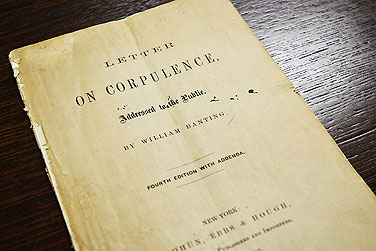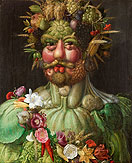News
Libraries’ exhibits offer tasty treats

Among the items on Display in the Health Science Library is “Letter on Corpulence,” a popular brochure by William Banting, an English funeral director, on the successful low-carb diet he followed when previous methods, including taking “50 Turkish baths,” had failed. Image: UNIVERSITY LIBRARIES
-
 Print
Print -
 Comments
Comments
-
You are what you eat: This image, displayed prominently in the Lockwood food exhibit, is by Guiseppe Arcimboldo (c. 1527-1593). Arcimboldo was famous “for his fantastic heads, composed of fruits or animals, landscapes, or implements,” according to Oxford Art Online. Click on the image to see a larger version. Image: UNIVERSITY LIBRARIES
Just in time for the food-filled holidays, the University Libraries is treating the campus community to a multi-site, multidimensional exhibit exploring the taste, history, culture, health aspects and even digestion of that which sustains us physically.
The exhibits continue through Jan. 31 in Lockwood Library, the Health Sciences Library on the South Campus, the Music Library in Baird Hall and the Silverman Library in Capen Hall.
Kathleen Quinlivan, communications officer for the University Libraries, says the exhibits began with informal discussion about food as a topic that everyone can enjoy. Charles Daniello, Donald Hartman and Cynthia Tysick planned the Lockwood show and invited librarians at other units to join them.
“Food is an inescapable topic, so we really weren’t surprised to find the work of so many scholars and writers studying the topic in its full diversity,” says Daniello, who emphasizes that the Lockwood exhibit offers “just a sampling,” so inexhaustible is the subject matter.
For instance, the display includes a fascinating section on New World foods and how they gradually made their way into the cuisines of European and Asian cultures. Another section displays colorful covers of many food-related books and videos in the Lockwood collection. The exhibit also looks at the origin of quickie and convenience foods in American culture, as well as organic agriculture.
“We thought the emphasis on New World foods might be interesting to many of our students because it shows that so many of the plants central to their national cuisines come from the New World,” says Daniello. “New World cuisines, of course, also reflect the early introduction of Old World plants and animals. In fact, the exchange of plants and animals between the Old and New worlds was an important aspect of the first globalization. Sometimes this is referred to as the Columbian Exchange (after Columbus’ ‘discovery’ of America). The repercussions of this food exchange affected not only nutrition and diet and much more, but also economics, politics and demographics. The repercussions were rapid and are ongoing.”
Also at Lockwood, one especially interesting section looks at Civil War military rations, including an actual sample of the “hardtack” consumed by countless hungry soldiers and sailors, and a recipe to make your own. Among the many books and videos highlighted are those arranged thematically with legends on food in literature (“Jane Austen and Food”), in different cultures (“Matzoh Ball Gumbo,” “Planet Taco”) and culinary and social issues (“American Tuna,” “Pork: A Global History”). Videos include feature films with a food theme (“Babette’s Feast”) and documentaries on the social aspects of food production and distribution.
“Food is one of those topics that is so broad and so multifaceted that it really lends itself well to this kind of treatment,” says Nancy Schiller, engineering librarian in Silverman. Her display takes on the controversy over genetically modified foods and uses case studies to present the topic more dynamically. “This topic is very emotionally and politically charged, so it’s important to present it in a balanced way,” says Schiller. “Case studies are great vehicles for doing that, for presenting both sides of an issue.”
The exhibit shows, for instance, how hypothetical students from different cultural backgrounds have sharply contrasting views of corporate biotechnology. Another section helps visitors understand what it means to leave a carbon footprint. This is done through a detailed calculation involving a bag of potato chips and why, by extension, sustainability is such a complex concept.
A trip down the spine to the Music Library reveals a far different take on food, but with its own fascinations and peculiarities. Nancy Nuzzo, director of music and special collections, says she was initially unsure she could fill the cases. “In the end, I was surprised at how many more directions I could have explored,” Nuzzo says. “When the notion of a food exhibit first came up, I immediately thought of the ‘Whipped Cream and Other Delights’ album cover. A few years ago, the ‘Inner Sleeve’ column in The Wire had a memorable piece about this cover and the parodies it inspired. I had been looking for an excuse to put the cover in an exhibit ever since!”
Tafelmusik or “table music” from the Middle Ages and Renaissance attracted the interest of many composers, and “was an obvious theme to give the exhibit some scholarly content,” she adds. Other items on view include part of a score from Leonard Bernstein’s “La Bonne Cuisine” for voice and piano in which the composer set four recipes from a classic French culinary text.
From the musical to the medical, the exhibit moves to the digestive and dietary in the Health Sciences Library display. Among the personalities highlighted is U.S. Army surgeon William Beaumont (1785-1853), who was briefly stationed at Fort Niagara and authored a seminal text, “Experiments and Observations on the Gastric Juice, and the Physiology of Digestion” in 1833. The exhibit describes Beaumont’s experiments on a patient, Alexis St. Martin, “a Canadian who had a hunting accident and was left with a hole (through which one could visualize the digestive process) while in Fort Niagara,” explains Pamela Rose, the library’s Web services and promotion coordinator.
Another central figure in the display is William Banting, an English funeral director who authored a popular brochure, “Letter on Corpulence,” on his successful low-carb diet when previous methods, including taking “50 Turkish baths,” had failed. He lost 45 pounds by eating protein at every meal.
The exhibit traces other restrictive diets through the present era, noting Americans’ obsession with finding quick and easy ways to lose weight. Currently popular diets are carefully qualified; for instance, that low-carb diets are known to have “numerous adverse effects,” notwithstanding the rapid weight loss that is possible. The display also covers the history of USDA food guidelines and analyzes the products of digestion.
The exhibits involved many contributors, among them David Bertuca and Mark Ludwig (Lockwood); Keith Mages, Linda Lohr, Liz Stellrecht and Michelle Zafron (Health Sciences Library); and Fred Stoss and Ben Wagner (Silverman).


Reader Comments